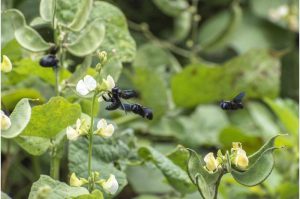Urbanization found to increase seasonal differences in plant-pollinator networks

Carpenter bees (Xylocopa sp) at Lablab in Bengaluru. Credit: Vikas S Rao
Increasing urbanization worldwide is a growing threat to biodiversity. At the same time, flowering plants are often more diverse in cities than in the countryside. This is due to flowering plants and agricultural crops, which are increasingly being grown in cities. A recent study shows that the interactions between plants and pollinators, which are essential for agricultural production, are surprisingly dynamic.
For example, the plant and bee species involved in pollination vary significantly between the seasons. This was shown by an international research team led by the University of Göttingen. The scientists studied farms that produce vegetables in the southern Indian metropolis of Bengaluru—a classic example of a rapidly growing city in the tropics.
Urbanization intensifies the seasonal differences in plant-pollinator networks, as a comparison of urban and rural cultivation areas revealed. The results were published in the journal Ecology Letters.
To identify influences on the interactions between pollinators and plants, the researchers analyzed 36 vegetable-producing farms in Bengaluru every month for a year. In this way, they covered the seasons that are characteristic of the local climate: the mild-dry winter, the hot-dry summer, and the rainy monsoon.
The farms were distributed along two routes that ran from the city center to the rural villages. The researchers recorded the bee species at each site, the plant species visited by bees, and the frequency of these interactions.
From the data, they identified plant-pollinator networks for each location and each season. They analyzed which factors explain differences in the interactions: the time of year, or the distance from the city center, or the degree of urbanization as indicated by the proportion of “sealed surfaces” such as roads, buildings, or pavements.
“Our study provides new insights into the role of urbanization in the dynamics of networks involving plants and pollinators in the tropics, which have been little studied. This is particularly important as current and future urban expansions are largely occurring in tropical regions, where they are subject to different ecological, climate, and social factors than in temperate zones,” explains first author Dr. Gabriel Marcacci, a former Ph.D. student in the Functional Agrobiodiversity research group at the University of Göttingen and now a postdoc at the Swiss Ornithological Institute and the University of Neuchâtel.
“Our results point to major changes in plant-pollinator networks over the course of the year and to the little-recognized importance of seasonality for the interactions between plants and their pollinators, especially in rapidly growing tropical megacities,” say co-authors Professors Catrin Westphal and Teja Tscharntke from the University of Göttingen and Ingo Grass from the University of Hohenheim.
The research was carried out as part of an interdisciplinary DFG research group that investigates changes in socio-ecological systems at the interface of urban and rural environments in India.
More information: Gabriel Marcacci et al, Urbanization alters the spatiotemporal dynamics of plant–pollinator networks in a tropical megacity, Ecology Letters (2023). DOI: 10.1111/ele.14324
Journal information: Ecology Letters
We are here to share current happenings in the bee industry. Bee Culture gathers and shares articles published by outside sources. For more information about this specific article, please visit the original publish source: https://phys.org/news/2023-12-urbanization-seasonal-differences-plant-pollinator-networks.html








